As I immerse myself in the enchanting realm of trending plants, the Philodendron Birkin emerges as a captivating focal point.
This botanical marvel not only boasts stunning variegation but also stands out for its ease of care, making it a standout choice in the dynamic landscape of popular and fashionable indoor flora.
The Philodendron Birkin, adorned with its striking creamy white or yellow streaks accentuating deep green leaves.
Has become a symbol of horticultural elegance, setting the tone for contemporary plant enthusiasts and influencing the latest trends in greenery.
Not only does it elevate my home decor, but it also purifies the air, making it a top choice for indoor plant enthusiasts.
Admired for its easy-going temperament and adaptability, the Philodendron Birkin is a choice beginner houseplant, adding a refreshing burst of green to any corner.
It thrives with minimal fuss, yet for those eager to see this beauty flourish.
I’m here to offer tailored philodendron birkin care tips whether you’re starting your first indoor garden or adding to your growing collection.
Introduction to Philodendron Birkin Care
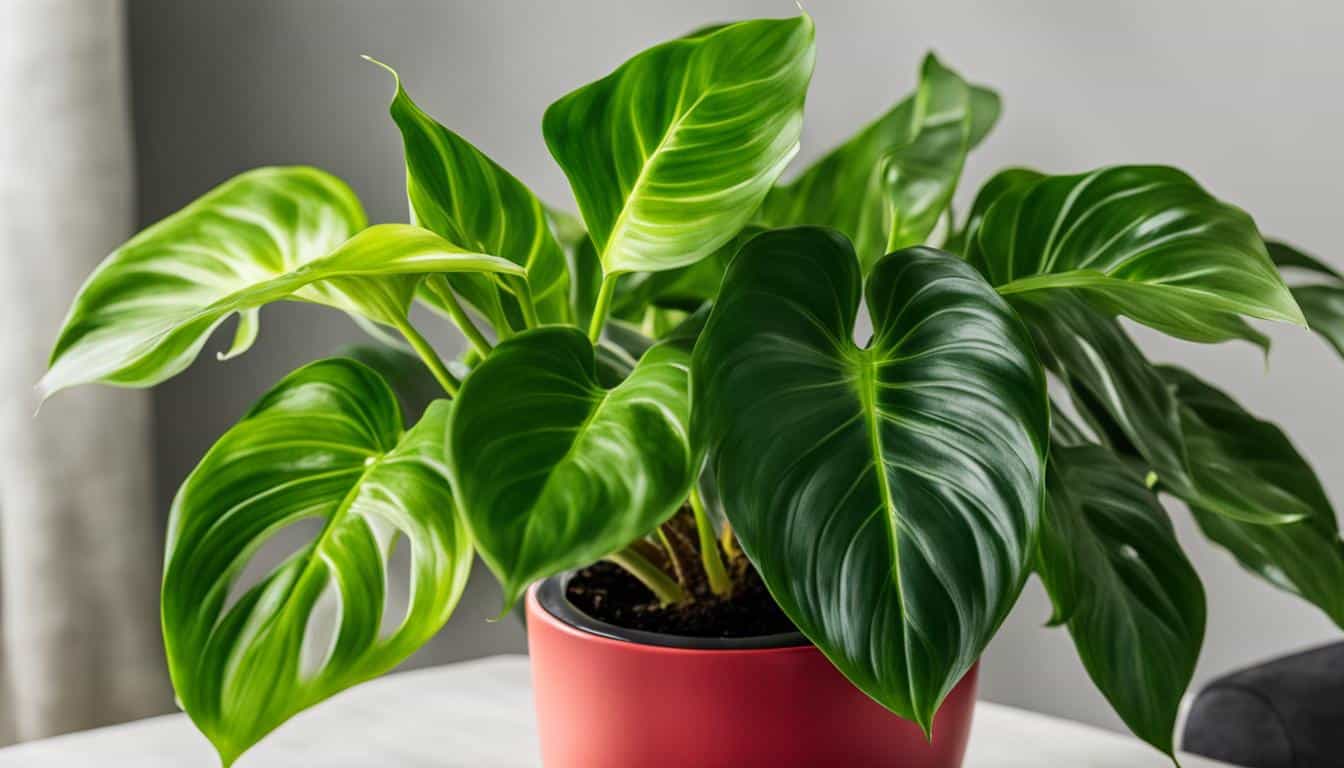
| Common Name | White wave, Birkin white wave, philodendron Birkin |
|---|---|
| Botanical Name | Philodendron ‘Birkin’ |
| Family | Araceae |
| Plant Type | Tropical evergreen perennial |
| Mature Size | – Grows up to 3 feet tall and 3 feet wide. – Features broad, lush green leaves with white veins that develop into white stripes and spots as the plant matures. |
| Sun Exposure | – Grows best in bright, indirect sunlight. – Can tolerate partial shade. – Requires protection from direct sun which can scorch the leaves. |
| Soil Needs | – Thrives in loose, well-draining potting mix. – Maintain consistent moisture but do not allow soil to become waterlogged. |
| Temperature Range | – Thrives in average home temperatures between 60-80°F. – Cannot tolerate frost – best grown as a houseplant. |
| Hardiness Zones | – Best grown indoors in zones 9-11. – Can be transitioned outside in shade during warm months. |
| Humidity Requirements | – Appreciates average to high indoor humidity of 40% or higher. – Mist leaves frequently or place pot on a pebble tray. |
| Toxicity | – Toxic to people and pets if leaves or stems are ingested. – Should be kept out of reach from children and animals. |
| Native Area | Central America |
| Hardiness Zones | – Best grown indoors in zones 9-11 – Can be transitioned outside in shade during warm months |
Embarking on the journey of nurturing a Philodendron Birkin, a prized gem among beginner houseplants.
I’m often reminded of the delicate balance required to maintain its mesmerizing variegation. Even though this plant relishes in its reputation as low-maintenance.
Philodendron birkin plant care involves more than the occasional water and light. Let’s explore how to nurture your Philodendron Birkin to ensure it thrives in your care.
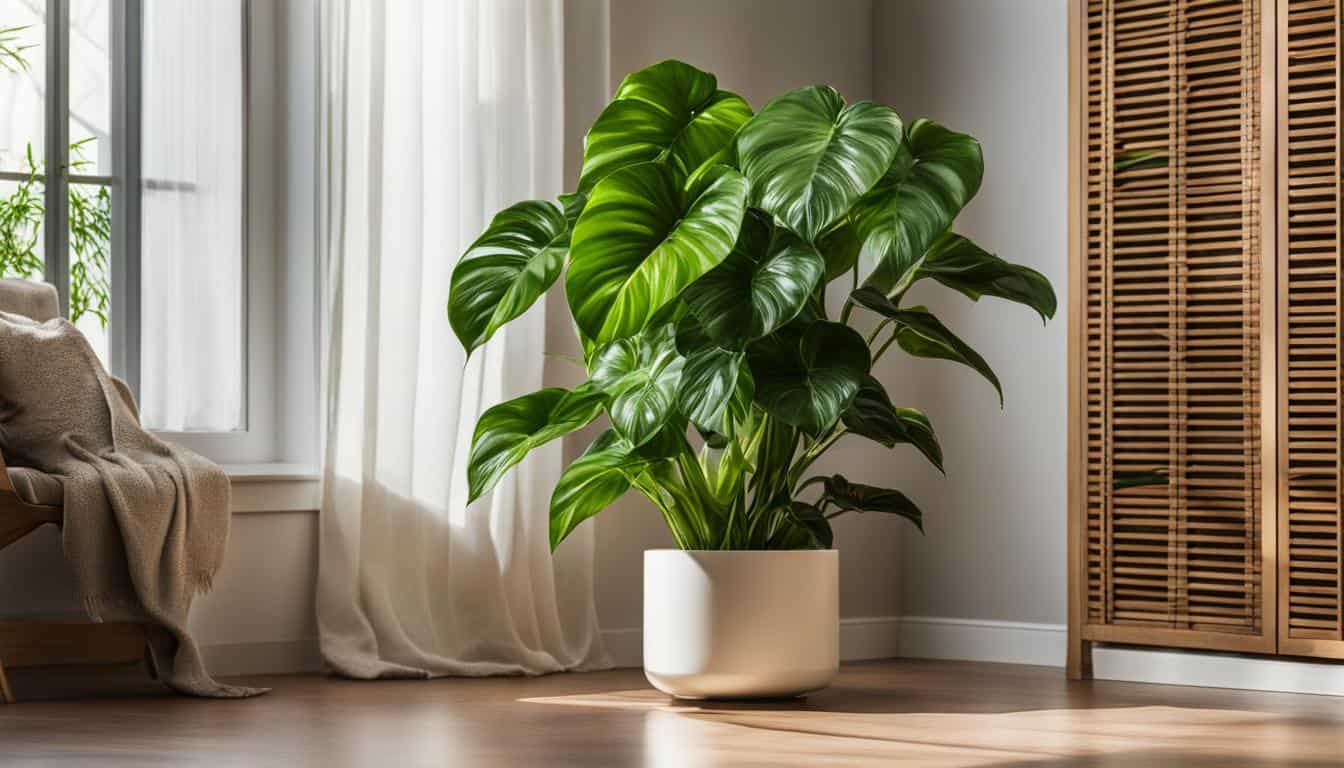
A quintessential choice for budding plant enthusiasts, the Philodendron Birkin is celebrated for its ease of care and striking appearance.
However, like all living things, it demands attention and specific conditions to reveal its full potential.
As I tend to my own Birkin, I’ve learned that the secret to its care lies in understanding its environmental preferences and responding to its subtle cues for water and nutrients.
In nurturing a Philodendron Birkin, timing and moderation are key.
Too much of a good thing be it water, fertilizer, or sunlight can quickly become detrimental, leading to problems such as root rot or burned leaves.
Conversely, too little of these essentials can hinder growth and cause coveted variegations to fade into monotony.
One of the most satisfying aspects of philodendron birkin plant care is the active engagement with the plant.
Regularly wiping down the leaves with a damp cloth is more than a cleaning ritual it’s an act of care that keeps the foliage glossy while encouraging the distinctive variegation to come forth.
This interaction deepens the connection between plant and caregiver, fostering a relationship where each living entity thrives.
- Proper Lighting: Although it thrives in bright, indirect sunlight, the Philodendron Birkin can succumb to leaf scorch in direct rays. It is important to find that sweet spot where light filters softly onto its leaves, coaxing out the luscious variegation without overwhelming the plant.
- Moderate Moisture: The rule of thumb for watering is simple – ensure that the soil remains moist, but never waterlogged. Waiting until the topsoil dries out between waterings is a strategy that promotes root health.
- Occasional Fertilization: A diluted balance of houseplant fertilizer every few months will suffice to nourish your Birkin without overwhelming it with unnecessary additives.
- Right Warmth: Keeping the environment warm is essential, particularly for a tropical plant like the Philodendron Birkin. It revels in temperatures that mimic its native habitat.
As these components come together in harmony, the Philodendron Birkin stands as a testament to the careful balancing act that is plant care.
Now, let’s delve into the specific care aspects that will keep our Philodendron Birkin plants looking their variegated best.
“Nurturing Philodendron Birkin is akin to conducting a symphony. Each element, from light to water, plays a distinct role in crafting the perfect conditions for the plant to flourish.”
Learn More About Philodendron Birkin Reverting
Understanding Philodendron Birkin’s Light Requirements
As I tend to the captivating Philodendron Birkin in my living space, I am constantly attuned to the importance of light in nurturing its vibrant presence.
The philodendron birkin light requirements are fairly specific, yet manageable, and acknowledging this has enabled me to cultivate a stunning specimen that attracts the attention of everyone who visits.
Achieving the ideal balance of philodendron birkin sunlight requirements is pivotal to maintaining the aesthetic appeal of this beloved houseplant.
I’ve discovered that filtered light, particularly from a west- or east-facing window, offers the perfect medium bright, indirect illumination this plant craves.
Direct sunlight is too harsh, capable of inflicting damage upon its delicate foliage.
Beneath the filtered rays, my Philodendron Birkin unveils its full grandeur, the leaves unfurling with their unique, creamy streaks unmarred by the sun’s scathing touch.
“The Philodendron Birkin’s affair with sunlight is a delicate dance—not too little, lest its variegation dim; not too much, lest its leaves burn.”
To prevent the lopsided growth often seen in houseplants that turn towards their light source, I’ve adopted a simple routine of rotating my Philodendron Birkin regularly.
This periodic rotation ensures balanced exposure, promoting even growth and all-angle beauty.
Let me lay out this data in an easy-to-digest format:
| Light Exposure | Outcome |
|---|---|
| Bright, Indirect Light | Optimal growth and variegation |
| Low Light | Reduced variegation, stretched growth |
| Direct Sunlight | Scorched leaves, faded colors |
| Even 360° Exposure (via rotation) | Symmetrical growth, uniform variegation |
This approach, coupled with attention to the natural fluctuations in light throughout the seasons, ensures my Philodendron Birkin’s luminous variegation remains the centerpiece of my green sanctuary.
Learn More About Philodendron Birkin’s Light Requirements
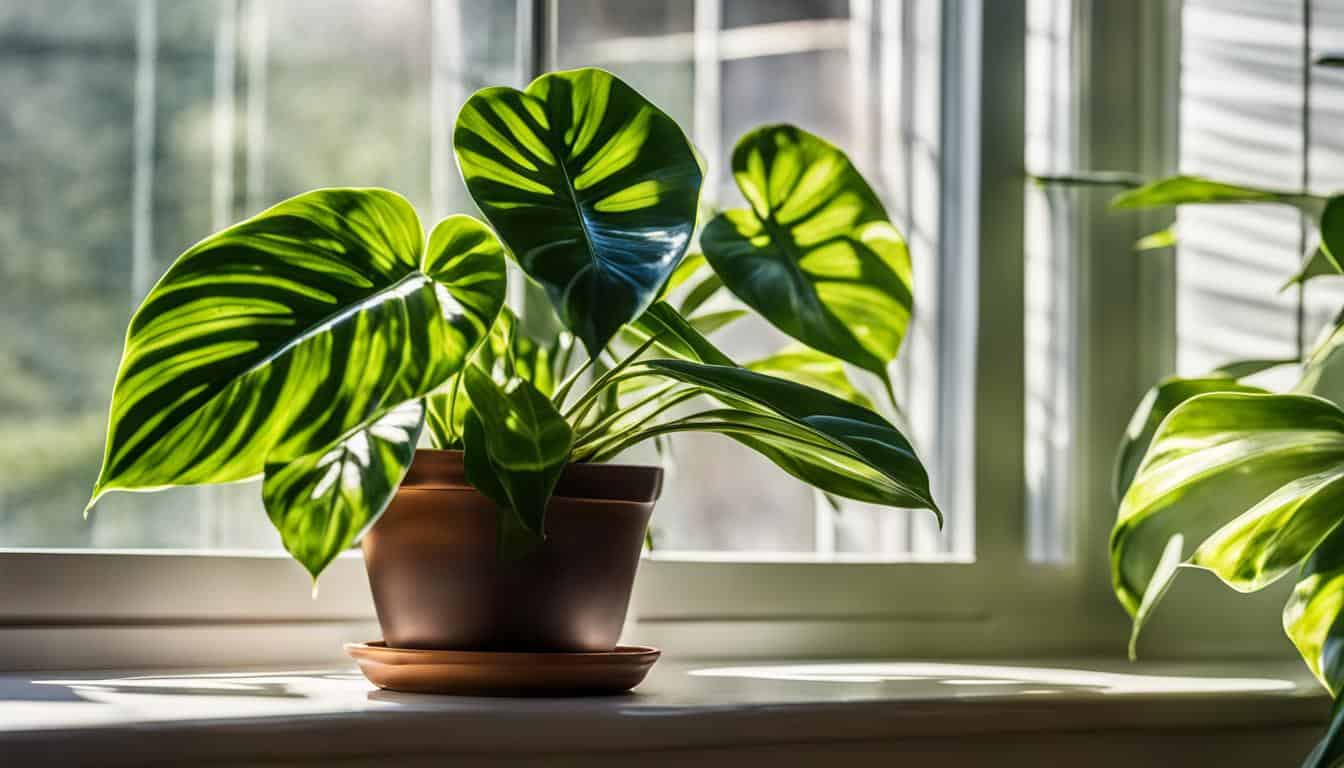
The Art of Watering Your Philodendron Birkin
Mastering the hydration for Birkin plant is akin to achieving a fine balance in a delicate dance where each movement counts.
Your Philodendron Birkin’s health largely depends on your approach to watering understand this, and you present your plant with the life source it needs to thrive.
Achieving optimal moisture ensures the plant’s glossy foliage and vibrant variegation flourish beautifully.
Learn More About Philodendron Birkin Watering
Watering Schedule for Optimal Moisture
My philodendron birkin watering schedule is structured around a simple rule: consistency.
I provide my Birkin plant with a thorough drink once the top couple of inches of soil feel dry to the touch about once a week.
But I always verify soil moisture with a quick finger test, rather than relying on the calendar alone.
In doing so, I cater to the plant’s needs while also adapting to seasonal changes that affect indoor humidity and temperature.
Signs of Underwatering and Overwatering
Vigilance in observing your plant’s feedback is crucial in watering philodendron birkin properly.
Keep an eye out for the philodendron birkin signs of underwatering such as wilting or curling leaves, which plead for more frequent waterings.
On the other spectrum, signs of overwatering like yellowing leaves or a wilt that doesn’t resolve after watering may suggest you’ve been too generous with hydration or your potting mix isn’t draining well enough.
“Providing just the right amount of water to your Philodendron Birkin isn’t just about nourishment; it’s an essential step in maintaining the plant’s aesthetic appeal.”
Best Practices for Hydrating Philodendron Birkin
To optimally water my Birkin, I ensure it’s potted in a container with drainage holes, allowing excess water to escape.
This optimal watering philodendron birkin practice safeguards against the dreaded root rot and maintains the airflow these tropical plants so dearly love.
Following smart watering practices has made hydration for Birkin plant quite a rewarding routine.
As each thoughtful watering contributes to the lush, variegated splendor that makes Philodendron Birkin a prized possession in the plant community.
Here are the core pointers in a table format which I follow for effective Birkin plant hydration:
| Action | Indication | Response |
|---|---|---|
| Touch Soil | Top 2″ Dry | Time to Water |
| Observe Leaves | Yellow or Wilted | Adjust Watering |
| Ensure Drainage | Excess Water | Protect Roots |
With each pouring, I’m mindful of my beloved plant’s cues it’s rewarding to witness my Philodendron Birkin thrive as a direct result of my attention to its watering needs.
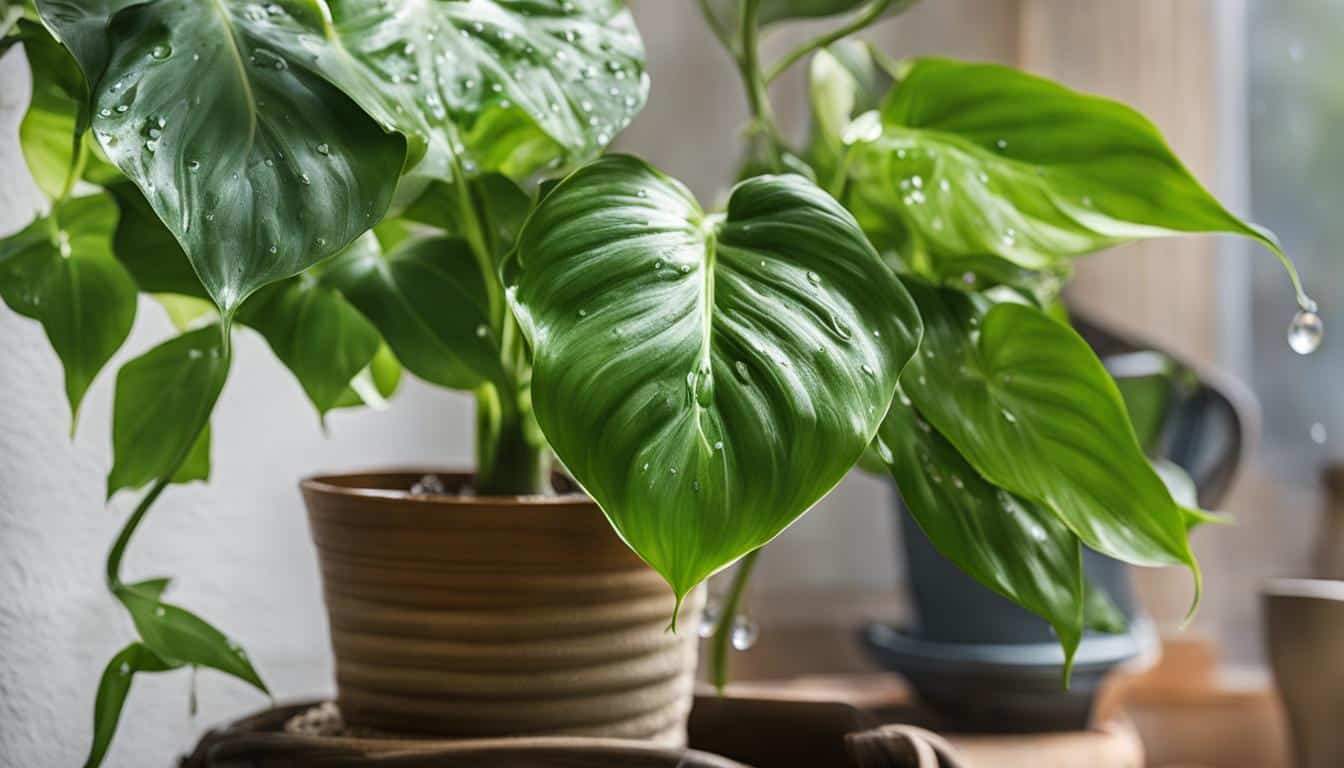
Choosing the Right Soil for Philodendron Birkin
When cultivating the beauty of a Philodendron Birkin, selecting the best soil for philodendron birkin is akin to laying the foundation for a masterpiece.
Just as a painter’s canvas influences the final artwork, the philodendron birkin soil can significantly determine the health and visual appeal of your plant.
I’ve experimented with various soil mixtures and found a blend that offers the perfect home for the Birkin’s roots.
The ideal soil mix should be well-draining yet capable of retaining just enough moisture to quench the plant’s thirst.
This supports a balanced hydration cycle, fostering lush growth without the dangers of waterlogging.
My go-to concoction combines potting soil with airy elements like orchid bark and perlite, adding structure and breathability to the mix.
Here’s a breakdown of why these components are essential for creating the best soil for philodendron birkin:
- Potting Soil: Rich in nutrients and able to hold moisture, it serves as the base for your mix.
- Orchid Bark: Chunky pieces provide spaces within the soil, promoting airflow and encouraging healthy root systems.
- Perlite: These little white specks aren’t just decorative; they improve drainage and help prevent compaction.
While finding a pre-mixed aroid soil could suffice, creating my own mix allows me to tweak proportions to my Birkin’s liking, ensuring that acidity and moisture retention align with its preferences.
Witnessing the thriving foliage as a result of this tailored approach is an indescribable joy a confirmation of the synergy between carer and plant.
“To define the best soil is to understand the silent language of your Philodendron Birkin’s needs, creating an environment where it can root deeply and rise beautifully.”
For those who prefer a visual representation, let’s outline the soil composition in a table to illustrate how each part of the blend contributes to the health of the Philodendron Birkin:
| Soil Component | Function | Benefit to Philodendron Birkin |
|---|---|---|
| Potting Soil | Moisture Retention & Nutrient Provision | Keeps roots hydrated and fed |
| Orchid Bark | Increased Aeration & Drainage | Enhances root health and prevents rot |
| Perlite | Improved Drainage & Space Creation | Prevents soil compaction and supports root formation |
With each repotting, I treasure the opportunity to fill my Philodendron Birkin’s pot with this carefully crafted mix, setting the stage for yet another chapter of robust growth and show-stopping variegation.
And I do so with the assurance that I’ve given it the best home possible—right beneath its ever-unfurling leaves.
Learn More About Philodendron Birkin Soil
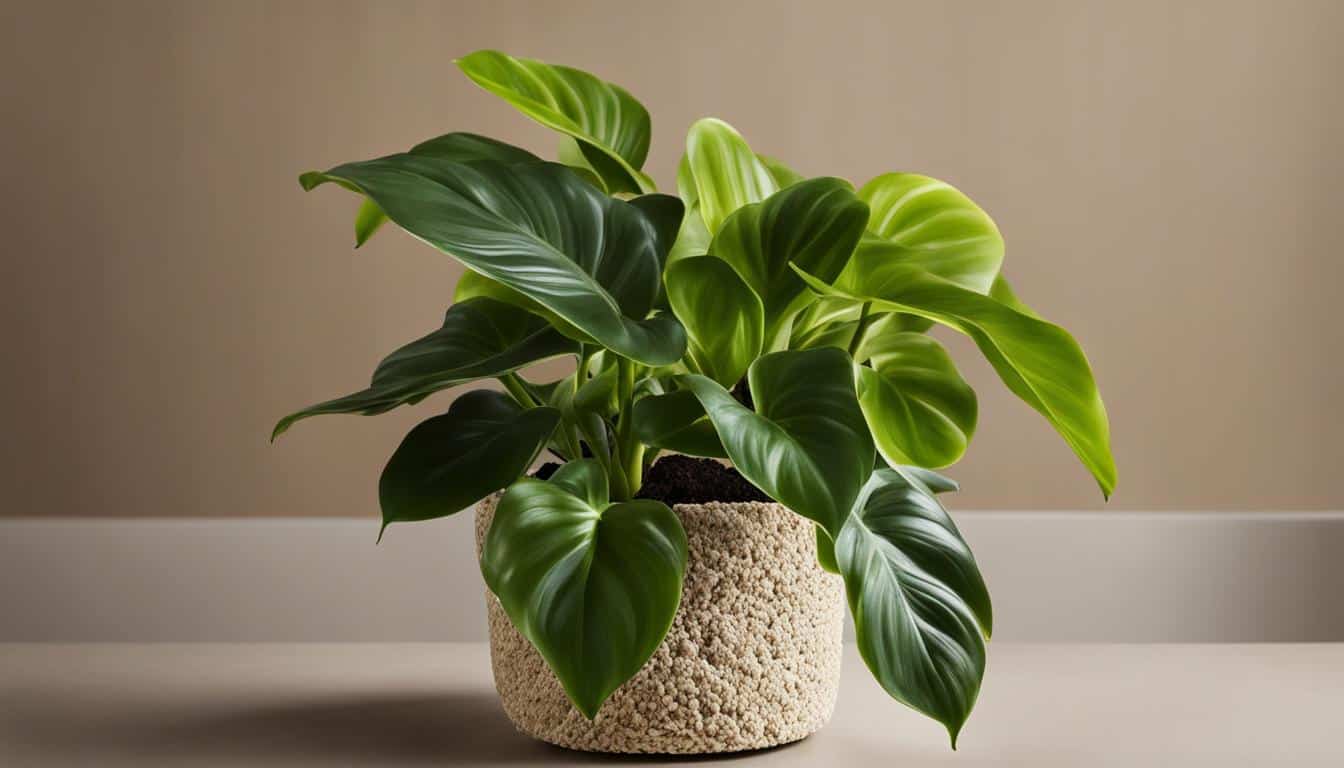
The Role of Fertilizer in Philodendron Birkin Growth
As I reflect on the flourishing greenery in my home, I recognize the pivotal role that feeding philodendron birkin with the right fertilizer plays in my gardening routine.
The philodendron birkin fertilizer that I use not only supports robust growth but also enhances the distinctive variegated patterns that make this plant so captivating.
Sharing my personal experiences and recommendations for fertilization will hopefully guide fellow plant lovers in enriching their Birkin’s vibrancy.
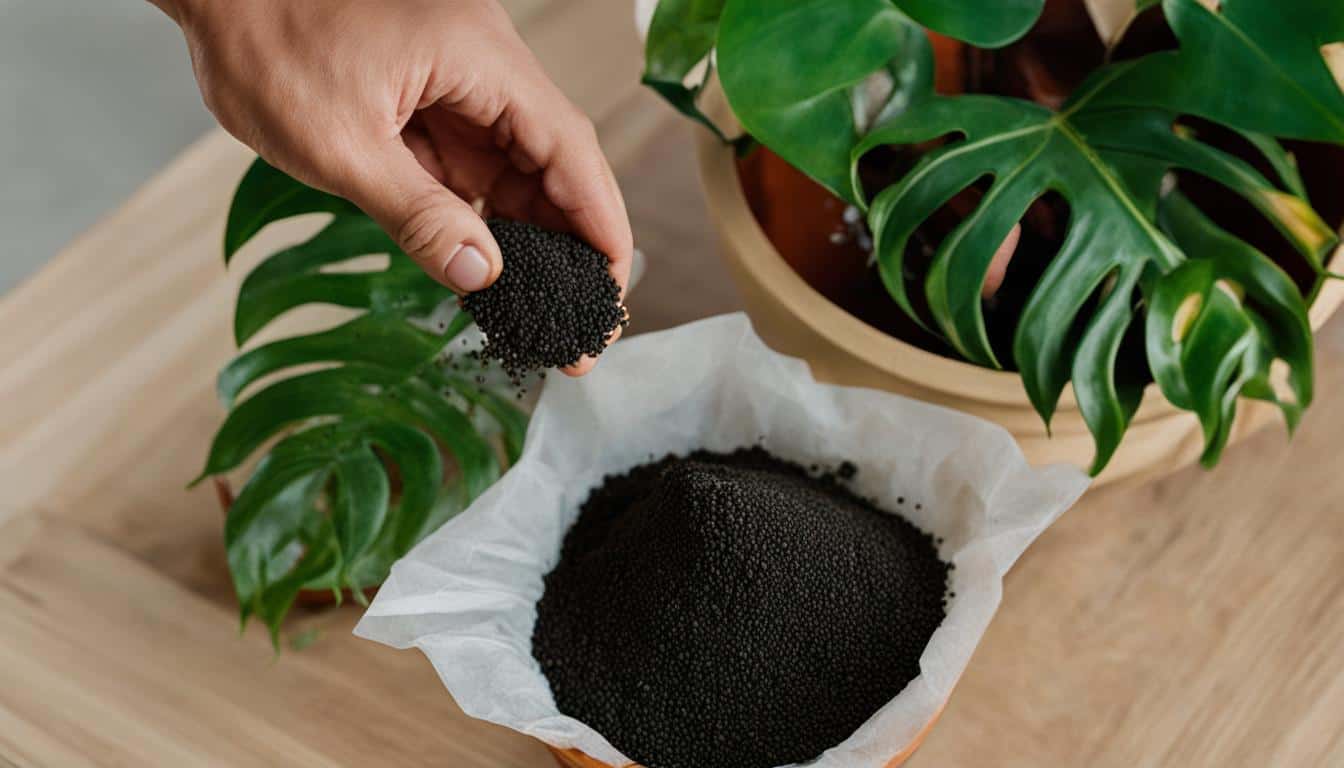
Understanding that the Philodendron Birkin is not a heavy feeder is key.
However, a light touch of balanced, diluted houseplant fertilizer introduced every few months during its growth seasons can be the secret to unlocking its potential.
This method of feeding philodendron birkin encourages not just faster growth, but also the maintenance of those alluring creamy white streaks that make the Birkin’s foliage so stunning.
“In every dose of fertilizer lies an opportunity to enhance the inherent beauty of the Philodendron Birkin, revealing a lush canvas of leaves that are vibrant and full of life.”
- The recommended ratio for a balanced fertilizer mix is a 20-20-20 composition.
- A diluted solution ensures that vital nutrients are delivered without overwhelming the plant’s sensitive root system.
- Avoid high nitrogen concentrations, which can prompt foliage growth at the expense of variegation.
While fertilizing is an essential aspect of plant care, overfertilization is a constraint we must be mindful of, as it may lead to detrimental effects.
Signs of overfeeding include a buildup of fertilizer salts in the soil and yellowing of the leaves a signal for me to alter my feeding regimen.
| Fertilizer Type | Function | Frequency | Season |
|---|---|---|---|
| Balanced 20-20-20 | Overall growth | Every few months | Spring/Summer |
| Low Nitrogen Formula | Encourage variegation | Less frequently | Spring/Summer |
| Slow-Release Pellets | Gradual nutrient release | Every 3-4 months | Spring/Summer |
My diligent attention to the philodendron birkin fertilizer needs helps me foster a lush, vibrant plant that becomes a focal point in my indoor garden.
Let us not forget that with the right feeding regime, our Philodendron Birkins will repay us with growth and beauty that truly reflect the care we put into them.
Maintaining Ideal Temperature and Humidity for Philodendron Birkin
As a plant enthusiast, I’ve learned the importance of mimicking a Philodendron Birkin’s natural environment to ensure it thrives.
Meeting the optimal philodendron birkin temperature and humidity requirements engenders vibrant growth and enhances the variegated foliage that we cherish.
Let me guide you through the nuances of creating humidity for Philodendron Birkin and ensuring the temperature is just right, especially when adjusting philodendron birkin care seasonally.
Creating a Tropical Environment Indoors
True to its tropical origins, the Philodendron Birkin prospers in warmer climes. Striving to maintain indoor temperatures that don’t dip below 55 degrees Fahrenheit is essential.
However, my Birkin reveals its best self when I keep the thermostat consistently set between 65 to 85 degrees Fahrenheit.
Moreover, achieving the humidity levels of 50 to 60 percent transforms my living space into a mini rainforest, accommodating my Birkin’s preferences.
Living in a drier climate doesn’t spell disaster for Birkin owners. Utilizing tools such as a humidifier has become part of my Philodendron Birkin care routine, helping keep the moisture in the air at an ideal level.
An alternative I use is a pebble tray filled with water, nestled right under the plant pot, to give off a gentle mist of humidity as the water naturally evaporates.
“Crafting a miniature tropical oasis within the walls of my home has been a rewarding venture, not just for my Philodendron Birkin, but for all my indoor plants.”
Seasonal Adjustments to Temperature and Humidity
The changing seasons bring vicissitudes to our indoor atmospheres, which can affect the Philodendron Birkin’s well-being.
Winter’s chill and dry air require modifications to our heating and humidifying strategies to maintain a stable environment.
I ensure to keep my plants away from drafty windows and too-close proximity to heating vents which can disrupt the delicate balance of their preferred conditions.
Summertime, conversely, often offers ample warmth but can at times introduce excessive dryness. During these months.
I pay close attention to humidity fluctuations and adjust my humidifier settings as needed or increase the water in the pebble tray to compensate.
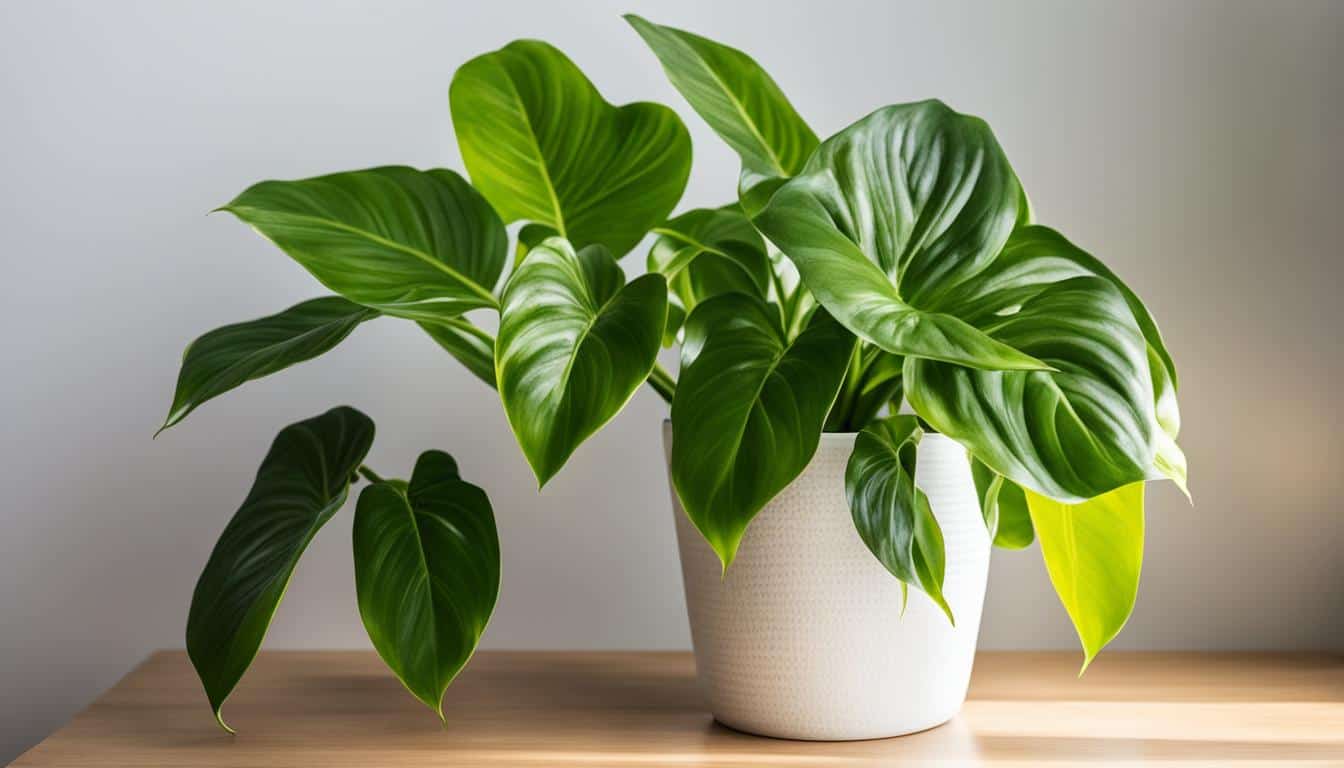
It’s a fine balance, one that requires patience and constant tweaking, but keeping my Birkin hearty is well worth the effort. For the sake of clarity, here is a table summarizing the temperature and humidity tweaks:
| Season | Temperature | Humidity Adjustments |
|---|---|---|
| Spring/Summer | Aim for 65-85°F | Use humidifier or pebble tray as needed |
| Fall/Winter | Keep above 55°F | Increase humidity, avoid drafts and direct heat |
With the right amounts of heat and moisture, my Philodendron Birkin enjoys a year-round summer, setting the stage for sustainable growth and the continued enchantment of its variegated leaves.
- Regular monitoring of the indoor climate safeguards against seasonal changes impacting the Birkin
- Ensuring the temperature does not fall below the Philodendron Birkin’s lowest tolerance keeps it in a comfortable growth zone
- Creating humidity can be as complex as using a humidifier or as simple as a pebble-water tray solution, both of which work wonders
Supporting Your Philodendron Birkin with Staking
As an enthusiastic indoor gardener, I’ve observed that my mature Philodendron Birkin, with its robust foliage.
Sometimes requires additional support to maintain its upright posture and encourage vertical growth. This is where staking philodendron birkin comes into play a process I find both essential and rewarding.
Beyond mere aesthetics, staking is a practical technique that secures the stability of this top-heavy plant.
Ensuring it displays its variegated leaves proudly without the risk of toppling over or bending at the stem.
“To stake or not to stake isn’t just a question—it can define the stature and health of your growing Philodendron Birkin.”
When I decided it was time for supporting my birkin plant, I chose materials that would complement its natural beauty while providing the sturdiness required. Here’s how you can do the same:
- Select a stake that is tall enough to support the full height of your plant—a bamboo stick or a moss pole are aesthetically pleasing options that blend seamlessly with foliage.
- Insert the stake gently into the soil near the stem, being mindful not to damage the root system.
- Simply tie the plant to the stake with soft garden ties or old stockings, allowing some room for growth and movement—remember not to cinch too tightly as this may damage the stem.

| Benefit | Description |
|---|---|
| Improved Stability | Stakes provide a solid anchor, preventing top-heavy specimens from leaning or falling. |
| Encouraged Vertical Growth | With a directional guide, the Birkin can focus energy on growing upright rather than supporting itself. |
| Aesthetically Pleasing Structure | Properly staked plants exhibit a more natural and organized appearance, akin to their native habitat. |
Being involved in staking philodendron birkin is not just about care it’s about shaping the environment in which these fantastic plants can exhibit their full grandeur.
So as I continue to foster the beauty of this striking variety, I find staking to be an integral element of supporting birkin plant care one that harmonizes structure with the mesmerizing patterns of its foliage.
How to Propagate Philodendron Birkin
Propagating my cherished Philodendron Birkin is a fulfilling endeavor that allows me to multiply the beauty of this elegant houseplant.
It’s an easy process that rewards patience and careful attention, creating new plants for myself or to share.
Let’s explore the steps and care necessary to ensure successful philodendron birkin propagation.
The Step-by-Step Guide to Propagation
My experience with propagating birkin plant can be distilled into a few clear steps.
Firstly, I choose a healthy stem on my Birkin – ensuring it’s about 4 to 5 inches in length and has several leaves.
With a clean, sharp pair of scissors or pruning shears, I snip the cutting just below a node – an area where leaves emerge, and where roots will develop.
It’s vital to remove the bottom leaves, leaving only a couple on top, to expose the nodes.
“Ease of propagation is yet another reason to embrace the delightful Philodendron Birkin within your collection.”
Next, I place my cutting in a clear jar filled with water, taking care that only the nodes are submerged while the leaves remain above.
A spot with bright, indirect light is ideal for this stage – it should not be too dim nor should it have direct sunshine. I maintain the water level and replace it every few days to keep it clean.
Patience really is a virtue since it may take about two to four weeks for those tiny white roots to make their appearance. Once they reach around an inch in length, it’s finally time to move the cutting into soil.
Caring for Your New Philodendron Birkin Cuttings
After propagation, transitioning my philodendron birkin cuttings into their new home requires a specific environment.
The cuttings thrive in moist, well-draining soil similar to their parent plant. For this, I use a typical aroid mix, known for its excellent drainage and aeration characteristics.
“Offering the right care for philodendron birkin cuttings right from the start fosters a stronger, more resilient plant.”
It’s important to maintain the same bright, indirect lighting situation to encourage growth and to keep the soil evenly moist but not soggy.
This prevents potential rot and creates the optimal conditions for the young Birkin to establish itself.
Monitoring soil moisture is particularly crucial during the first few weeks after transferring the cuttings to soil.
My personal routine involves sticking a finger into the soil to ensure the top layer has dried slightly before watering again, as overwatering during this tender phase can be detrimental.
Here’s a concise table that simplifies the care regimen I follow for my juvenile Philodendron Birkin plants:
| Care Aspect | Instructions |
|---|---|
| Light | Place in bright, indirect light |
| Water | Keep soil evenly moist, not waterlogged |
| Soil Type | Use a moist, well-draining aroid mix |
Mindful care during these stages is a gateway to a healthy Philodendron Birkin plant that holds the promise of the parent’s beauty and vigor.
As you witness the young plants begin to flourish with glossy leaves and characteristic variegation, you’ll appreciate the reward that accompanies the propagation process.

Troubleshooting Common Philodendron Birkin Problems
As I cultivate my collection of indoor plants, I have encountered and overcome several common birkin plant issues.
The Philodendron Birkin, despite its hardy nature, can sometimes exhibit signs of distress. Through careful observation and prompt action.
I’ve developed successful strategies for troubleshooting philodendron birkin problems. Here, I’ll walk you through identifying and addressing some of the most frequent issues this plant may face.
“Awareness and timely intervention are key to keeping your Philodendron Birkin in peak condition.”
Yellow, brown, or curled leaves might be upsetting but are often a signal that your plant is asking for help.
It’s important to assess the situation thoroughly before reacting. Let’s take a closer look at these symptoms and how to address them effectively.
- Yellow Leaves: Often a giveaway that I’ve been overenthusiastic with watering. Dialing back on hydration usually helps, but I also ensure that the pot has proper drainage to avoid water accumulation.
- Brown Crispy Leaves: These are telltale signs that the air is too dry for my Birkin’s liking. I’ve found that increasing humidity through pebble trays or a humidifier does wonders.
- Curling Leaves: This is an alert that my plant isn’t getting enough water. Implementing a more consistent watering routine usually remedies the issue.
Additionally, dropping or leaning leaves may hint at insufficient light or a less than optimal temperature range. Here’s a detailed table that outlines these common problems and suggested solutions:
| Symptom | Possible Cause | Solution |
|---|---|---|
| Yellow Leaves | Overwatering or Poor Drainage | Reduce watering frequency; Improve drainage |
| Brown Crispy Leaves | Low Humidity | Increase humidity levels |
| Leaning Stems | Inadequate Light | Move to a brighter spot with indirect sunlight |
| Curling Leaves | Underwatering | Establish regular watering routine |
| Dropping Leaves | Suboptimal Temperature | Ensure consistent indoor temperature |
Every philodendron birkin owner should remember that these plants are adaptable and often bounce back with proper care adjustments.
Regular monitoring and adjustments based on the plant’s feedback lead to a healthy and visually stunning Birkin.
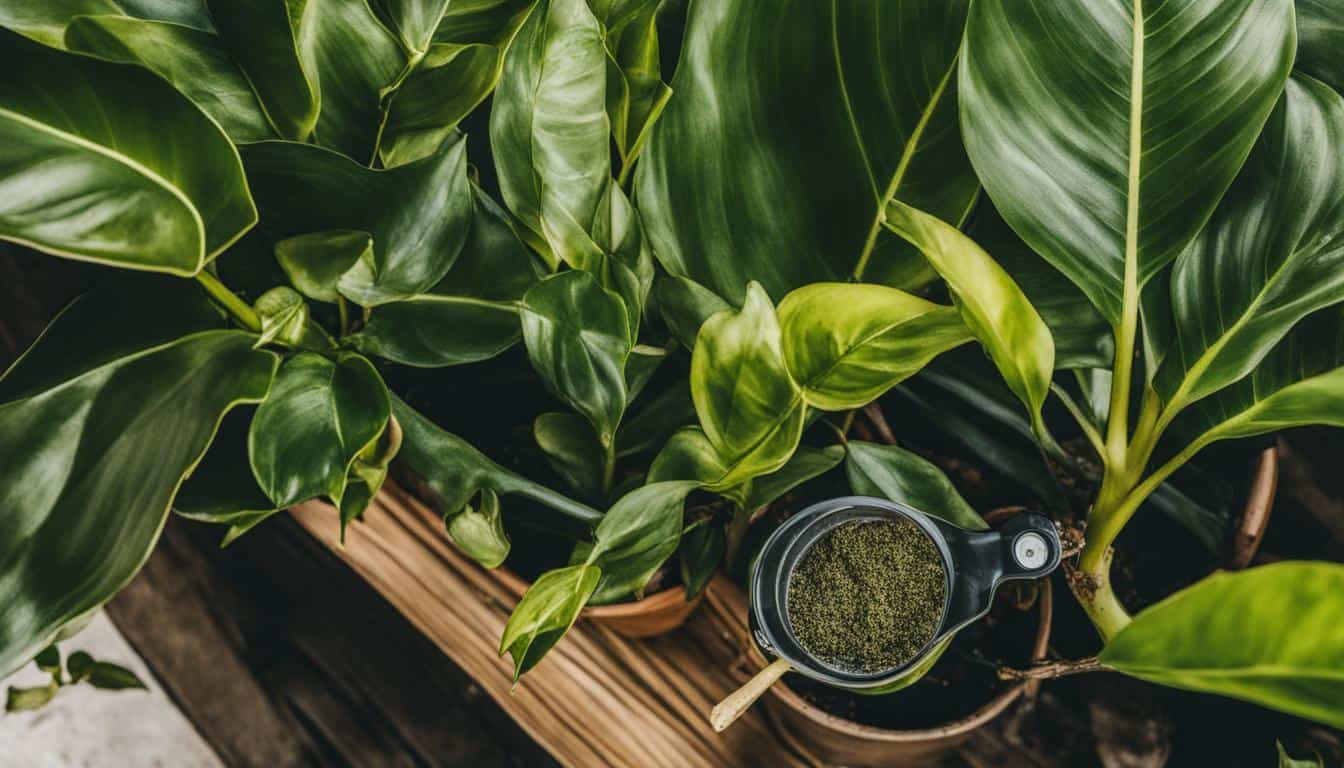
Addressing Philodendron Birkin’s Yellow Leaves
As an avid cultivator of the Philodendron Birkin, I’ve observed a common concern many plant enthusiasts encounter the development of yellow leaves.
In my quest for a lush, variegated display, I’ve learned key insights into fixing yellow leaves on birkin.
Here, I’ll share the actions and considerations that have been instrumental in my own Birkin’s care.
Firstly, it’s important to recognize that witnessing philodendron birkin yellow leaves at the bottom of the plant is a natural part of its growth cycle.
However, when the yellowing occurs in the newer foliage, it signifies a need to re-evaluate my watering habits and the plant’s environment.
“Yellow leaves can signal distress, but through careful assessment and prompt adjustment, they also guide us towards healthier plant care practices.”
Assessing the moisture levels in the soil with a touch a method both simple and effective has allowed me to adjust my watering routine to better suit my Birkin’s needs.
- If the soil feels soggy, I hold off watering and consider improving drainage by verifying that the nursery pot allows unobstructed water flow.
- Should the soil dry out too rapidly, I ensure even and consistent hydration without drenching the roots.
Adopting a systematic approach, I monitor the changes in my Birkin’s foliage as I adjust these variables. To visualize and aid fellow growers in addressing this common issue, I’ve compiled a table detailing the potential causes and remedies for yellow leaves on your Philodendron Birkin:
| Cause of Yellow Leaves | Signs to Look For | Corrective Action |
|---|---|---|
| Overwatering | Yellowing of new growth; soggy soil | Reduce watering frequency; increase drainage |
| Poor drainage | Water pools at the bottom of the pot | Ensure pot has adequate drainage holes; consider soil mix with better aeration |
| Natural aging | Yellowing of lower, older leaves | Gentle removal of the yellowed leaves to redirect energy to healthier growth |
| Environmental stress | Generalized yellowing; other signs of stress | Review and modify light exposure, humidity, temperature |
In my experience, the quest to keep the Philodendron Birkin’s foliage vibrant and healthy is rewarding.
Through observation and responsive care to its environment, this striking plant continues to thrive and brings joy to my indoor garden.

Nurturing Variations of Philodendron Birkin
Delving into the diverse world of the Philodendron Birkin, I have been fascinated by the striking variations that this plant can produce.
Even with a collection centered around this variant, the splashes of color in philodendron birkin green and the rare instances of pink birkin philodendron have sparked a particular interest within the community.
Each leaf, with its varying shades, speaks volumes about the health and maturity of the plant.
Learn More About Variegated Philodendron Birkin
Philodendron Birkin Green and Pink Varieties
When discussing the classic variations of philodendron birkin, the discussion often gravitates towards the green variety with white stripes.
Yet, during my time caring for these plants, I have observed that new leaves can sometimes emerge with a stunning pink hue, creating a breathtaking contrast.
While this pink variegation may fade as the leaves mature, it is a phase of growth that is cherished by many plant enthusiasts.
“The beauty of the Philodendron Birkin stretches beyond its well-known white markings. The subtle pink and pronounced green nuances on new leaves illustrate the dynamic changes a birkin can display as it matures.”
Learn More About Philodendron Birkin Pink

Caring for Mature Philodendron Birkin Form
As for mature philodendron birkin care, it has been my experience that these plants require only minimal pruning to remove any spent or damaged leaves, which allows the plant to focus on healthy growth.
The sophisticated patterns of older plants, often showcasing denser and more intricate variegation, illuminate the importance of nurturing mature birkin form.
- Mature Birkins should still be given ample indirect light to maintain their variegation.
- Soil moisture needs should be checked regularly, providing water when necessary but avoiding over-saturation.
- Fertilizing should remain consistent with the less-is-more approach, favoring liquid fertilizers that can be diluted and applied during active growth seasons.
To preserve the grandeur of your mature Birkin’s form, consider repotting every few years.
Refreshing the soil with a well-draining mix can invigorate an older plant and support continued growth.
Here’s a summary of my approach to maintaining a vibrant, mature Birkin:
| Action | Reason |
|---|---|
| Minimal Pruning | Encourages energy focus on healthy foliage. |
| Indirect Light | Preserves leaf variegation. |
| Monitor Moisture | Prevents root rot and maintains hydration. |
| Conservative Fertilizing | Supports growth without overfeeding. |
| Occasional Repotting | Refreshes soil and allows for growth expansion. |
Despite the age and stage of your Philodendron Birkin, the joy it brings as an indoor plant remains consistent.
With proper care, these variations continue to flourish, each bringing their unique blend of color and pattern to the forefront of our plant collections.
Learn More About Repotting Philodendron Birkin
Toxicity and Pet Safety for Philodendron Birkin
While the Philodendron Birkin may be a visual delight in our homes, its inherent philodendron birkin toxicity commands respect and necessitates precaution.
Containing calcium oxalate crystals, the same beguiling leaves can pose a danger to both people and pets when ingested, causing significant discomfort and health issues.
“The safety of our furry companions and young ones is paramount when cultivating a collection that includes the stunning yet toxic Philodendron Birkin.”
Ensuring pet safety with birkin plant is a responsibility I take seriously as a plant parent. By placing this elegant specimen out of reach.
I can prevent any unintended nibbles which could lead to emergency vet visits.
Should an incident occur where a pet ingests any part of the plant, I know to seek immediate veterinary care.
I have structured a table, as an easy reference, to outline steps I’ve taken to ensure safety and the actions required in the event of accidental ingestion:
| Preventive Measures | Toxicity Symptoms | Immediate Actions |
|---|---|---|
| Place plants on high shelves or hanging planters | Mouth and throat irritation | Contact veterinarian or poison control |
| Use of plant cages when necessary | Difficulty swallowing | Provide a description of the plant ingested |
| Educate household on potential dangers | Excessive drooling or vomiting | Keep the plant for identification |
| Regularly inspect plants for fallen leaves | Loss of appetite | Follow professional medical advice |
It is invaluable to remain vigilant and informed about the plants we bring into our homes, especially those like the Philodendron Birkin.
Though harmless to look upon, the potential for toxicity cannot be overlooked. With the right measures in place.
We can coexist safely and harmoniously with these exquisite plants, enjoying their beauty without fear for the safety of our pets and children.
Learn More About Philodendron Birkin Toxic to Cats

Understanding the Cost Factors of Philodendron Birkin
Delving into the nuances of plant economics, I find that the philodendron birkin price is shaped by a variety of factors.
As an enthusiast keen on adding this plant to my collection, I have explored what drives the cost of this popular houseplant.
Factors Influencing Philodendron Birkin Price
The pricing dynamics of the Birkin are fascinating, given its distinctive variegation and the fact that it’s a natural mutation of another philodendron species. Here are core reasons heightening the plant’s value:
“The uniqueness and scarcity of the Philodendron Birkin’s striking variegation have a significant impact on its market demand and, subsequently, its price.”
- Limited Supply: As a rare natural mutation, these plants are not as readily available as more common philodendron species.
- Growth Rate: The Birkin’s slow-growing nature means it takes longer for nurseries to cultivate sale-ready plants, contributing to its premium pricing.
- Variegation Appeal: The plant’s aesthetic—with patterns that are individually unique—makes each Birkin a piece of natural art, factoring into the philodendron birkin cost.
Let’s crunch some numbers and see how these factors reflect in the pricing:
| Factor | Impact on Price |
|---|---|
| Rarity | Higher price due to limited availability |
| Growth Rate | Increased value for older, fully variegated specimens |
| Variegation Quality | Unique patterns command a premium |
Where to Buy Philodendron Birkin
For those wondering where to buy philodendron birkin, myriad options exist. Each source offers its advantages, whether it’s the expertise from a specialist nursery or the convenience of online shopping.
- Specialized Nurseries: Experts at these locations often provide plants with a proven care record and vivid variegation.
- Online Plant Stores: They offer a broad selection, sometimes at varying price points, making it easy to find a Birkin within your budget.
- Local Garden Centers: Shopping locally allows you to handpick your plant, assessing its health and fullness on the spot.
While searching for a philodendron birkin for sale, I also consider:
“Investing in a Philodendron Birkin, for me, is not just about acquiring a plant; it’s about welcoming a unique living sculpture into my home.”
Overall, understanding the cost before you buy philodendron birkin will equip you with the insight to make informed decisions.

Conclusion
In the dynamic world of indoor foliage, nurturing a Philodendron Birkin proves both a joy and a journey.
This indoor plants guide has aimed to equip you with the essential knowledge to elevate your plant care routine.
The Philodendron Birkin, with its striking variegation and lush greenery, accentuates any space, making it a prized possession for enthusiasts and newcomers alike.
By following a comprehensive philodendron birkin care guide, you can ensure this exquisite plant thrives under your watchful eye.
Creating the optimal environment for your Birkin, balancing light, water, and nutrients, while maintaining the appropriate humidity levels, encapsulates the essence of nurturing philodendron birkin.
As you become more attuned to its needs, you’ll find that caring for the Birkin is not merely about upkeep but involves fostering a thriving relationship between you and your plant.
It’s this interactive process that makes growing Philodendron Birkin so rewarding.
Remember, whether you’re creating the right soil blend or proactively managing a pest situation, the health of your Philodendron Birkin mirrors the attention to detail paid in its day-to-day care.
As you incorporate these practices seamlessly into your routine, you’ll join the ranks of those who find deep contentment in seeing their indoor plants flourish.
This guide is not just a reference; it’s an invitation to experience the satisfying pursuit that is the art of plant care.
Pro Tips for Your Philodendron ‘Birkin’ Plant
- Keep out of direct sunlight, which can burn leaves and fade coloring. Provide bright, indirect light instead.
- Increase humidity through a humidifier or pebble tray. These tropical plants need consistent 50-60% humidity.
- Prune away dead or damaged leaves to encourage new growth and prevent disease. Make clean cuts near the stems.
- Repot every 1-2 years in spring when root-bound. Gently loosen roots before placing in slightly larger pot with fresh soil to stimulate growth.
FAQ
How often should I water my Philodendron Birkin?
Water your Philodendron Birkin approximately once a week, allowing the topsoil to dry out slightly between waterings. Be cautious to avoid overwatering, which can lead to root rot.
What are the ideal light conditions for a Philodendron Birkin?
The Philodendron Birkin thrives in medium bright, indirect light. A west- or east-facing window where the sunlight is filtered is ideal. Direct sunlight should be avoided to prevent leaf scorching.
What type of soil is best for Philodendron Birkin?
A well-draining, rich soil mix composed of potting soil, orchid bark, and perlite is excellent for a Philodendron Birkin. It should retain moisture while still providing good aeration and drainage.
When and how should I fertilize my Philodendron Birkin?
Fertilize your Philodendron Birkin every few months during the growing season with a balanced, diluted houseplant fertilizer. Avoid overfertilization, which can damage the roots and yellow the leaves.
What temperature and humidity levels does a Philodendron Birkin prefer?
Philodendron Birkin enjoys temperatures between 65 to 85 degrees Fahrenheit and humidity levels of 50 to 60 percent. Ensure you protect the plant from drastic temperature changes and maintain the humidity around it.
How do I support my Philodendron Birkin as it grows?
If your Philodendron Birkin becomes top-heavy, you can support it by staking. Use a moss pole or stake gently inserted next to the plant’s stem to help it maintain its upright growth.
How can I propagate a Philodendron Birkin?
To propagate a Philodendron Birkin, take a 4- to 5-inch stem cutting below a leaf node, remove the bottom leaves, and place it in water until roots develop. Once a good root system is established, plant it in soil.
What are common Philodendron Birkin problems and their solutions?
Common problems include yellow leaves from overwatering, brown crispy leaves from underwatering, and curling leaves due to dryness or inadequate light. Adjust your care routine accordingly, and ensure the plant is in an environment with correct humidity and light levels.
Why are my Philodendron Birkin’s leaves turning yellow?
Yellow leaves can indicate overwatering or possible nutrient deficiencies. Check your watering schedule and ensure the plant is draining properly. Modifying your fertilization routine may also help.
Are there different Philodendron Birkin varieties?
Yes, there are variations of Philodendron Birkin such as those with green or pink accents in their variegation. These colors may be prominent on new leaves and can change as the leaves mature.
Is Philodendron Birkin toxic to pets?
Yes, Philodendron Birkin is toxic to pets and children if ingested due to calcium oxalate crystals. Keep the plant out of reach to prevent accidental ingestion.
How much does a Philodendron Birkin cost, and where can I buy one?
The cost of a Philodendron Birkin varies based on size, variegation, and availability. It can range from moderate to high due to its rarity. You can find them at specialized nurseries, online plant shops, and garden centers.
